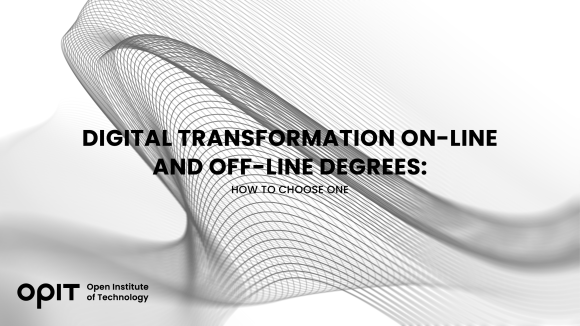

According to Statista, close to 85% of people in the EU use the Internet daily. That’s a huge population that demands a working digital infrastructure and expects online services to function seamlessly. This has resulted in extreme demands for digitizing online services across industries and sectors, with seven of the 10 most prominent companies in the world focusing on digital platforms. The process has been dubbed the Fourth Industrial Revolution.
With the advent of digital-first business accelerated by the COVID-19 pandemic, many companies are seeking experts in digital transformation to adapt to new practices. These positions are highly sought after and compensated accordingly, with the average yearly salary for digital transformation experts in Germany being €96K. In the U.S., similar positions can pay up to $200K per year.
That’s where the best online master’s degrees in digital transformation come in. Outfitted with future-proof knowledge and practices, you, too, can lead companies in making these pivotal changes. What’s important is to choose the best programs—like the one from OPIT—to give you the necessary edge and expertise in this forward-facing career.
Understanding the Value of Online Education in Digital Transformation
At its core, digital transformation is firmly entrenched in technology use and relies on many principles brought out by rapid globalization. All industries rely on technology and digital systems in one way or another, whether those are services, sales, marketing, or even production. And technology is changing more quickly than the educational systems can keep up.
With online education, the curriculum can adapt to the most recent advancements in the industries, from optimized data tracking to AI use. It allows direct access and a deeper dive into the same platforms you’ll be using during practical work. The basic practices you learn during an online curriculum can be immediately applied to real-life work and extrapolated onto custom projects in your career.
Furthermore, online teaching evens out educational opportunities across the globe. So long as you have an internet connection, you can access world-class education piloted by leaders regardless of the institution you wish to enroll in.
Online learning also allows you to set your own learning pace. It’s an excellent option if you’re already a career professional who wants to be more aligned with the needs of the modern world while still working full-time or providing for your family.
What to Look For in Top Online Digital Transformation Programs
With so many online and offline teaching programs that promise state-of-the-art education in digital transformation, it can be extremely challenging to find the best options. Here’s what you should look for in your digital transformation degree or course:
- Curriculum relevance: Digital transformation combines data science, management, and analysis and how technology affects businesses and entrepreneurs, which should be must-haves in the program. Also, look for classes that focus on engineering, finance, project or product management, and marketing.
- Innovative teaching: Due to the subject’s inherent reliance on available technology, opt for programs that have interactive tests, simulations of real-life events and platforms, and real-world practice projects.
- Industry partnerships: Look for programs supported by leading digital-first companies or those that provide internships and real-life projects as part of the dissertation.
- Accreditation: Find programs that are accepted as fully accredited Higher Education Institutions, such as the European Qualifications Framework (EQF), EAHEA, EQUIS, AMBA, and AACSB, or a member of an international body such as ENQA. It will ensure your degree is universally accepted.
- One-on-one teaching: Apart from traditional group teaching, look for courses that allow for dedicated one-on-one supplemental teaching and mentorship.
- Modern concepts: The course doesn’t need to teach just the theory of the currently dominant technologies and practices but also set up future concepts and teach a theoretical basis that accounts for future advancements.
Best Online Masters in Digital Transformation
Here are the top five options for your online digital transformation degree.
OPIT’s MSc in Applied Digital Business
Developed by industry leaders from modern educational institutions and leading companies such as Amazon, the EQF-accredited Open Institute of Technology has built the 18-month course in Applied Digital Business from the ground up. As a result, the course aims to train students for careers in digital transformation, data science, marketing, and business analysis. Due to its online-first nature, the course immerses you into the digital management sphere from the get-go, guiding you via a combination of theoretical analysis and practical projects.
In the first term, the program provides a detailed post-graduate education in data science, digital project management, problem-solving in the digital era, and customer value management analysis. In the second term, the course focuses on digital transformation, platform, and project management, as well as finance in the digital-driven economy. Finally, the course ends with a long-term research capstone project to consolidate your skills with full support from a faculty mentor.
It’s one of the most versatile programs available that will allow you to transfer your existing skills into modern practices and create opportunities for growth in both current and emerging industries. With support from global industry leaders, you get access to a wide network of peers to set you up for success.
University of Hull Online – MSc in Digital Transformation
This is a focused 2-year program in digital transformation, teaching the relevance of emerging technologies in modern digital systems, such as AI, blockchain, 3D printing, and quantum computing. However, the curriculum also contains subjects that touch on information and project management, how customers affect digital businesses, and digital innovation and strategy development. The program is fully online with a part-time commitment and optional group webinars, with the University of Hull accredited by AMBA.
University of Edinburgh Online – MSc in Digital Education
While not a focused master’s degree in digital transformation, this degree in digital education provides a well-rounded theoretical basis for working in the digital sphere. It focuses on how digitization will affect education, making it a lucrative choice for people employed in academia who want to future-proof their skills. It lasts from two to six years of part-time online study, and the university is currently ranked among the top 20 in the world.
ESSCA Online Campus – MSc in International Business 4.0 – Leading Green & Digital Transformation
ESSCA Online is a triple-accredited online school that teaches international business practices, digital transformation techniques, and sustainable operation management. It also provides an overview of blockchain, Web3, the metaverse, project management, fintech, and data analysis. It’s a 12- or 24-month program with case study programs and consulting projects with companies affiliated with ESSCA.
University of South Wales – MSc in Leading Digital Transformation
This degree course focuses on leadership, digital technologies, and innovation in the digital field, with a particular focus on the healthcare sector. However, it also teaches UX design, management within digital-only teams, and agile business practices. The program lasts for two years of part-time study (half a day each week) and is delivered through online real-time courses with guests from leading companies.
Why Opt for OPIT’s Digital Transformation Education Online
Traditional university programs commonly use the same in-person curriculum and just deliver the content online. However, OPIT’s education system is fully tuned towards online learning. You get to interact with lecturers worldwide and learn from industry leaders in real-time or on-demand. The program combines theoretical knowledge on modern topics with practical exams and assignments that put it to the test to ensure it sticks.
OPIT’s curriculum is also designed to be future-proof. The skills you learn in the master’s degree for digital transformation will be useful in solving future challenges with yet-to-be-conceived technology. It ensures that your career can last for years with minimal re-skilling and creates a path of lifetime improvement through practice.
Start Your Digital Transformation Journey
Earning a post-graduate degree in emerging technologies and concepts can push you forward as an expert for years to come. Choose OPIT as one of the best online digital transformation degree options and receive a stellar combination of theory and practice to provide you with real-world skills crucial for career development.
Related posts

Source:
- Agenda Digitale, published on November 25th, 2025
In recent years, the word ” sustainability ” has become a firm fixture in the corporate lexicon. However, simply “doing no harm” is no longer enough: the climate crisis , social inequalities , and the erosion of natural resources require a change of pace. This is where the net-positive paradigm comes in , a model that isn’t content to simply reduce negative impacts, but aims to generate more social and environmental value than is consumed.
This isn’t about philanthropy, nor is it about reputational makeovers: net-positive is a strategic approach that intertwines economics, technology, and corporate culture. Within this framework, digitalization becomes an essential lever, capable of enabling regenerative models through circular platforms and exponential technologies.
Blockchain, AI, and IoT: The Technological Triad of Regeneration
Blockchain, Artificial Intelligence, and the Internet of Things represent the technological triad that makes this paradigm shift possible. Each addresses a critical point in regeneration.
Blockchain guarantees the traceability of material flows and product life cycles, allowing a regenerated dress or a bottle collected at sea to tell their story in a transparent and verifiable way.
Artificial Intelligence optimizes recovery and redistribution chains, predicting supply and demand, reducing waste and improving the efficiency of circular processes .
Finally, IoT enables real-time monitoring, from sensors installed at recycling plants to sharing mobility platforms, returning granular data for quick, informed decisions.
These integrated technologies allow us to move beyond linear vision and enable systems in which value is continuously regenerated.
New business models: from product-as-a-service to incentive tokens
Digital regeneration is n’t limited to the technological dimension; it’s redefining business models. More and more companies are adopting product-as-a-service approaches , transforming goods into services: from technical clothing rentals to pay-per-use for industrial machinery. This approach reduces resource consumption and encourages modular design, designed for reuse.
At the same time, circular marketplaces create ecosystems where materials, components, and products find new life. No longer waste, but input for other production processes. The logic of scarcity is overturned in an economy of regenerated abundance.
To complete the picture, incentive tokens — digital tools that reward virtuous behavior, from collecting plastic from the sea to reusing used clothing — activate global communities and catalyze private capital for regeneration.
Measuring Impact: Integrated Metrics for Net-Positiveness
One of the main obstacles to the widespread adoption of net-positive models is the difficulty of measuring their impact. Traditional profit-focused accounting systems are not enough. They need to be combined with integrated metrics that combine ESG and ROI, such as impact-weighted accounting or innovative indicators like lifetime carbon savings.
In this way, companies can validate the scalability of their models and attract investors who are increasingly attentive to financial returns that go hand in hand with social and environmental returns.
Case studies: RePlanet Energy, RIFO, and Ogyre
Concrete examples demonstrate how the combination of circular platforms and exponential technologies can generate real value. RePlanet Energy has defined its Massive Transformative Purpose as “Enabling Regeneration” and is now providing sustainable energy to Nigerian schools and hospitals, thanks in part to transparent blockchain-based supply chains and the active contribution of employees. RIFO, a Tuscan circular fashion brand, regenerates textile waste into new clothing, supporting local artisans and promoting workplace inclusion, with transparency in the production process as a distinctive feature and driver of loyalty. Ogyre incentivizes fishermen to collect plastic during their fishing trips; the recovered material is digitally tracked and transformed into new products, while the global community participates through tokens and environmental compensation programs.
These cases demonstrate how regeneration and profitability are not contradictory, but can actually feed off each other, strengthening the competitiveness of businesses.
From Net Zero to Net Positive: The Role of Massive Transformative Purpose
The crucial point lies in the distinction between sustainability and regeneration. The former aims for net zero, that is, reducing the impact until it is completely neutralized. The latter goes further, aiming for a net positive, capable of giving back more than it consumes.
This shift in perspective requires a strong Massive Transformative Purpose: an inspiring and shared goal that guides strategic choices, preventing technology from becoming a sterile end. Without this level of intentionality, even the most advanced tools risk turning into gadgets with no impact.
Regenerating business also means regenerating skills to train a new generation of professionals capable not only of using technologies but also of directing them towards regenerative business models. From this perspective, training becomes the first step in a transformation that is simultaneously cultural, economic, and social.
The Regenerative Future: Technology, Skills, and Shared Value
Digital regeneration is not an abstract concept, but a concrete practice already being tested by companies in Europe and around the world. It’s an opportunity for businesses to redefine their role, moving from mere economic operators to drivers of net-positive value for society and the environment.
The combination of blockchain, AI, and IoT with circular product-as-a-service models, marketplaces, and incentive tokens can enable scalable and sustainable regenerative ecosystems. The future of business isn’t just measured in terms of margins, but in the ability to leave the world better than we found it.

Source:
- Raconteur, published on November 06th, 2025
Many firms have conducted successful Artificial Intelligence (AI) pilot projects, but scaling them across departments and workflows remains a challenge. Inference costs, data silos, talent gaps and poor alignment with business strategy are just some of the issues that leave organisations trapped in pilot purgatory. This inability to scale successful experiments means AI’s potential for improving enterprise efficiency, decision-making and innovation isn’t fully realised. So what’s the solution?
Although it’s not a magic bullet, an AI operating model is really the foundation for scaling pilot projects up to enterprise-wide deployments. Essentially it’s a structured framework that defines how the organisation develops, deploys and governs AI. By bringing together infrastructure, data, people, and governance in a flexible and secure way, it ensures that AI delivers value at scale while remaining ethical and compliant.
“A successful AI proof-of-concept is like building a single race car that can go fast,” says Professor Yu Xiong, chair of business analytics at the UK-based Surrey Business School. “An efficient AI technology operations model, however, is the entire system – the processes, tools, and team structures – for continuously manufacturing, maintaining, and safely operating an entire fleet of cars.”
But while the importance of this framework is clear, how should enterprises establish and embed it?
“It begins with a clear strategy that defines objectives, desired outcomes, and measurable success criteria, such as model performance, bias detection, and regulatory compliance metrics,” says Professor Azadeh Haratiannezhadi, co-founder of generative AI company Taktify and professor of generative AI in cybersecurity at OPIT – the Open Institute of Technology.
Platforms, tools and MLOps pipelines that enable models to be deployed, monitored and scaled in a safe and efficient way are also essential in practical terms.
“Tools and infrastructure must also be selected with transparency, cost, and governance in mind,” says Efrain Ruh, continental chief technology officer for Europe at Digitate. “Crucially, organisations need to continuously monitor the evolving AI landscape and adapt their models to new capabilities and market offerings.”
An open approach
The most effective AI operating models are also founded on openness, interoperability and modularity. Open source platforms and tools provide greater control over data, deployment environments and costs, for example. These characteristics can help enterprises to avoid vendor lock-in, successfully align AI to business culture and values, and embed it safely into cross-department workflows.
“Modularity and platformisation…avoids building isolated ‘silos’ for each project,” explains professor Xiong. “Instead, it provides a shared, reusable ‘AI platform’ that integrates toolchains for data preparation, model training, deployment, monitoring, and retraining. This drastically improves efficiency and reduces the cost of redundant work.”
A strong data strategy is equally vital for ensuring high-quality performance and reducing bias. Ideally, the AI operating model should be cloud and LLM agnostic too.
“This allows organisations to coordinate and orchestrate AI agents from various sources, whether that’s internal or 3rd party,” says Babak Hodjat, global chief technology officer of AI at Cognizant. “The interoperability also means businesses can adopt an agile iterative process for AI projects that is guided by measuring efficiency, productivity, and quality gains, while guaranteeing trust and safety are built into all elements of design and implementation.”
A robust AI operating model should feature clear objectives for compliance, security and data privacy, as well as accountability structures. Richard Corbridge, chief information officer of Segro, advises organisations to: “Start small with well-scoped pilots that solve real pain points, then bake in repeatable patterns, data contracts, test harnesses, explainability checks and rollback plans, so learning can be scaled without multiplying risk. If you don’t codify how models are approved, deployed, monitored and retired, you won’t get past pilot purgatory.”
Of course, technology alone can’t drive successful AI adoption at scale: the right skills and culture are also essential for embedding AI across the enterprise.
“Multidisciplinary teams that combine technical expertise in AI, security, and governance with deep business knowledge create a foundation for sustainable adoption,” says Professor Haratiannezhadi. “Ongoing training ensures staff acquire advanced AI skills while understanding associated risks and responsibilities.”
Ultimately, an AI operating model is the playbook that enables an enterprise to use AI responsibly and effectively at scale. By drawing together governance, technological infrastructure, cultural change and open collaboration, it supports the shift from isolated experiments to the kind of sustainable AI capability that can drive competitive advantage.
In other words, it’s the foundation for turning ambition into reality, and finally escaping pilot purgatory for good.
Have questions?
Visit our FAQ page or get in touch with us!
Write us at +39 335 576 0263
Get in touch at hello@opit.com
Talk to one of our Study Advisors
We are international
We can speak in:


